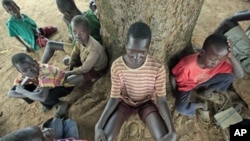Children in parts of Northern Uganda are dealing with a strange and extremely debilitating disease. Researchers on the ground have yet to pinpoint an origin, which is leaving the cure unknown.
It is called the nodding disease, for the effect of “nodding back and forth” it gives to the affected people.
It is mostly children who contract the disease, some as young as five. It causes epilepsy, seizures and, in some cases, blindness. The ministry of health in Uganda says there are now more than 3,000 cases of nodding disease affecting Ugandan children.
Pervasive illness
Rukia Nakamatte, a spokesperson for the ministry of health, has been in the affected northern areas. She describes how rampant and serious the disease has become.
“Most of them nod and most of them, because they have epilepsy, and they keep falling, you realize that most of them have injuries, some of the injuries on their legs, on their hands. It’s really a terrible situation, but we are controlling it,” said Nakamatte.
Since 2009, when the first case of nodding disease was recorded in Uganda, there have been 170 documented deaths. The government has been criticized for a slow response to treating what has become a disease quickly growing in numbers.
According to Nakamatte, some families can have multiple children affected.
“You might find that one family is affected, and it has about four cases. Another family that you know does not have any case, and another family that is a distance apart, has one case or a few. So they are scared. But they also know that this is something that is not contagious, but something that whose cause we have failed to know,” said Nakamatte.
Cause unknown
Researchers are still uncertain about the origins of the disease, but there are a few leads. Some believe the black-fly-borne parasite, which causes river blindness, may have a link, and they also have noticed a deficiency in vitamin B6 in the affected areas.
Dr. Joaquim Saweka, representative for the World Health Organization in Uganda, said teams are working simultaneously to both pinpoint the cause and treat the symptoms.
“It is important - early diagnosis. So good surveillance system, so that the case is detected in time before they evolve to more complicated epilepsy-like forms. Usually they respond very well to the medicine we use for epilepsy,” said Saweka.
With these epilepsy-like symptoms, Saweka said children with the nodding disease are extremely prone to accidents. Most of the deaths related to the disease have been from secondary causes.
“When the seizure come affect the child. There is even loss of consciousness, and then what happen if they are near the water, or a river, near the fire, so it can cause the reason that can lead to the death. And, even if the seizure too strong, can also end by the death of the child,” said Saweka.
And, until doctors and researchers find a cure, treating the symptoms of this unknown and debilitating disease will be first priority.
News
Northern Ugandan Children Affected by Unknown Disease
- By Alex Pena






